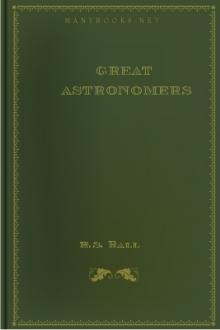The Story of the Heavens, Sir Robert Stawell Ball [snow like ashes series TXT] 📗

- Author: Sir Robert Stawell Ball
Book online «The Story of the Heavens, Sir Robert Stawell Ball [snow like ashes series TXT] 📗». Author Sir Robert Stawell Ball
Of the interior of the sun we can, of course, expect to learn little or nothing. What we observe is the surface-layer, the so-called photosphere, in which the cold of space produces the condensation of the gases into those luminous clouds which we see in our drawings and photographs as "rice grains" or "willow leaves." It has been suggested by Dr. Johnstone Stoney (and afterwards by Professor Hastings, of Baltimore) that these luminous clouds are mainly composed of carbon with those of the related elements silicon and boron, the boiling points of which are much higher than those of other elements which might be considered likely to form the photospheric clouds. The low atomic weight of carbon must also have the effect of giving the molecules of this element a very high velocity, and thereby enabling them to work their way into the upper regions, where the temperature has so fallen that the vapour becomes chilled into cloud. A necessary consequence of the rapid cooling of these clouds, and the consequent radiation of heat on a large scale, would be the formation of what we may perhaps describe as smoke, which settles by degrees through the intervals between the clouds (making these intervals appear darker) until it is again volatilised on reaching a level of greater heat below the clouds. This same smoke is probably the cause of the well-known fact that the solar limb is considerably fainter than the middle of the disc. This seems to arise from the greater absorption caused by the longer distance which a ray of light from a point near the limb has to travel through this layer of smoke before reaching the earth. It is shown that this absorption cannot be attributed to a gaseous atmosphere, since this would have the effect of producing more dark absorption lines in the spectrum. There would thus be a marked difference between the solar spectrum from a part near the middle of the disc and the spectrum from a part near the limb. This, however, we do not find to be the case.
With regard to the nature of sun-spots, the idea first suggested by Secchi and Lockyer, that they represent down rushes of cooler vapours into the photosphere (or to its surface), seems on the whole to accord best with the observed phenomena. We have already mentioned that the spots are generally accompanied by faculae and eruptive prominences in their immediate neighbourhood, but whether these eruptions are caused by the downfall of the vapour which makes the photospheric matter "splash up" in the vicinity, or whether the eruptions come first, and by diminishing the upward pressure from below form a "sink," into which overlying cooler vapour descends, are problems as to which opinions are still much divided.
A remarkable appendage to the sun, which extends to a distance very much greater than that of the corona, produces the phenomenon of the zodiacal light. A pearly glow is sometimes seen in the spring to spread over a part of the sky in the vicinity of the point where the sun has disappeared after sunset. The same spectacle may also be witnessed before sunrise in the autumn, and it would seem as if the material producing the zodiacal light, whatever it may be, had a lens-shaped form with the sun in the centre. The nature of this object is still a matter of uncertainty, but it is probably composed of a kind of dust, as the faint spectrum it affords is of a continuous type. A view of the zodiacal light is shown in Fig. 22.
In all directions the sun pours forth, with the most prodigal liberality, its torrents of light and of heat. The earth can only grasp the merest fraction, less than the 2,000,000,000th part of the whole. Our fellow planets and the moon also intercept a trifle; but how small is the portion of the mighty flood which they can utilise! The sip that a flying swallow takes from a river is as far from exhausting the water in the river as are the planets from using all the heat which streams from the sun.
The sun's gracious beams supply the magic power that enables the corn to grow and ripen. It is the heat of the sun which raises water from the ocean in the form of vapour, and then sends down that vapour as rain to refresh the earth and to fill the rivers which bear our ships down to the ocean. It is the heat of the sun beating on the large continents which gives rise to the breezes and winds that waft our vessels across the deep; and when on a winter's evening we draw around the fire and feel its invigorating rays, we are only enjoying sunbeams which shone on the earth countless ages ago. The heat in those ancient sunbeams developed the mighty vegetation of the coal period, and in the form of coal that heat has slumbered for millions of years, till we now call it again into activity. It is the power of the sun stored up in coal that urges on our steam-engines. It is the light of the sun stored up in coal that beams from every gaslight in our cities.
For the power to live and move, for the plenty with which we are surrounded, for the beauty with which nature is adorned, we are immediately indebted to one body in the countless hosts of space, and that body is the sun.
CHAPTER III.
THE MOON.
The Moon and the Tides--The Use of the Moon in Navigation--The
Changes of the Moon--The Moon and the Poets--Whence the Light of
the Moon?--Sizes of the Earth and the Moon--Weight of the
Moon--Changes in Apparent Size--Variations in its
Distance--Influence of the Earth on the Moon--The Path of the
Moon--Explanation of the Moon's Phases--Lunar Eclipses--Eclipses of
the Sun, how produced--Visibility of the Moon in a Total
Eclipse--How Eclipses are Predicted--Uses of the Moon in finding
Longitude--The Moon not connected with the Weather--Topography of
the Moon--Nasmyth's Drawing of Triesnecker--Volcanoes on the
Moon--Normal Lunar Crater--Plato--The Shadows of Lunar
Mountains--The Micrometer--Lunar Heights--Former Activity on the
Moon--Nasmyth's View of the Formation of Craters--Gravitation on
the Moon--Varied Sizes of the Lunar Craters--Other Features of the
Moon--Is there Life on the Moon?--Absence of Water and of Air--Dr.
Stoney's Theory--Explanation of the Rugged Character of Lunar
Scenery--Possibility of Life on Distant Bodies in Space.
If the moon were suddenly struck out of existence, we should be immediately apprised of the fact by a wail from every seaport in the kingdom. From London and from Liverpool we should hear the same story--the rise and fall of the tide had almost ceased. The ships in dock could not get out; the ships outside could not get in; and the maritime commerce of the world would be thrown into dire confusion.
The moon is the principal agent in causing the daily ebb and flow of the tide, and this is the most important work which our satellite has to do. The fleets of fishing boats around the coasts time their daily movements by the tide, and are largely indebted to the moon for bringing them in and out of harbour. Experienced sailors assure us that the tides are of the utmost service to navigation. The question as to how the moon causes the tides is postponed to a future chapter, in which we shall also sketch the marvellous part which the tides seem to have played in the early history of our earth.
Who is there that has not watched, with admiration, the beautiful series of changes through which the moon passes every month? We first see her as an exquisite crescent of pale light in the western sky after sunset. If the night is fine, the rest of the moon is visible inside the crescent, being faintly illumined by light reflected from our own earth. Night after night she moves further and further to the east, until she becomes full, and rises about the same time that the sun sets. From the time of the full the disc of light begins to diminish until the last quarter is reached. Then it is that the moon is seen high in the heavens in the morning. As the days pass by, the crescent shape is again assumed. The crescent wanes thinner and thinner as the satellite draws closer to the sun. Finally she becomes lost in the overpowering light of the sun, again to emerge as the new moon, and again to go through the same cycle of changes.
The brilliance of the moon arises solely from the light of the sun, which falls on the not self-luminous substance of the moon. Out of the vast flood of light which the sun pours forth with such prodigality into space the dark body of the moon intercepts a little, and of that little it reflects a small fraction to illuminate the earth. The moon sheds so much light, and seems so bright, that it is often difficult at night to remember that the moon has no light except what falls on it from the sun. Nevertheless, the actual surface of the brightest full moon is perhaps not much brighter than the streets of London on a clear sunshiny day. A very simple observation will suffice to show that the moon's light is only sunlight. Look some morning at the moon in daylight, and compare the moon with the clouds. The brightness of the moon and of the clouds are directly comparable, and then it can be readily comprehended how the sun which illuminates the clouds has also illumined the moon. An attempt has been made to form a comparative estimate of the brightness of the sun and the full moon. If 600,000 full moons were shining





Comments (0)